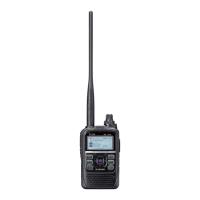4 - 2
4-2 TRANSMIT CIRCUITS
TX AF CIRCUITS (LOGIC AND MAIN UNITS)
The AF signal from the internal or external microphone (MIC
signal) is applied to the MIC AMP (LOGIC UNIT: IC19B, pin 5).
• When operating in the DV mode
The amplifi ed signal is passed through the MIC mute SW
(LOGIC UNIT: IC16, pins 1, 7), and then further amplifi ed by
the ALC AMP (LOGIC UNIT: IC14, pin 1). The amplifi ed sig-
nal is applied to the liner CODEC (LOGIC UNIT: IC15, pin 2),
through the buffer (LOGIC UNIT: IC12B, pins 6, 7), to be en-
coded into a digital audio signal.
The digital audio signal is processed by the DSP (LOGIC
UNIT: IC18), and then applied to the linear codec (LOGIC
UNIT: IC15) to be converted into the digital baseband signal.
The digital baseband signal is passed through the LPF (LOGIC
UNIT: IC12A, pins1, 3), and then applied to the MAIN UNIT.
The digital baseband signal is passed through the mode SW
(MAIN UNIT: IC8, pins 10, 11), and then applied to the D/A
converter (MAIN UNIT: IC11, pin 18) to be adjusted in level.
TX AMP CIRCUITS (MAIN UNIT)
The TX signal is passed through the buffer (Q48) and
attenuator (D20, D21) which controls the TX output power by
the APC AMP (IC14). The TX signal is sequentially amplifi ed
by the YGR (Q39) and drive AMP (Q41), and then passed
through the LPF (L42, C250, C351). The fi ltered TX signal is
applied to the power AMP (Q45).
The amplifi ed TX signal is passed through the LPF (L22, L24,
C260, C265, C267, C270), ANT SW (D24, D25), TX output
power detector (D26, D28) and two LPFs (L29, C281, C285
and L32, L34, C302, C303, C306, C307, C312), before being
applied to the antenna.
APC CIRCUITS (MAIN UNIT)
The voltage produced at the LPFs (L29, C281, C285 and
L32, L34, C302, C303, C306, C307, C312) is rectifi ed by D26
and D28, and it is used as the TX power sensing voltage.
The voltage is applied to the APC AMP (IC14, pin 7), and the
output voltage controls the bias voltages of attenuator (D20,
D21) to keep the TX output power constant.
MODULATION CIRCUITS (MAIN UNIT)
The MIC signal from the TX AF circuits is applied to the VCO
(Q27, D10–D12) as a modulation signal. The modulation sig-
nal is applied to D10 to obtain GMSK (For DV mode) or Fre-
quency Modulation (For FM mode).
The modulated VCO output signal is passed through the buf-
fer (Q30) and amplifi ed by the LO AMP (Q32), and then ap-
plied to the TX AMP circuits as the TX signal, through the LO
SW (D14).
HPF
J5
MIC
AMP
MC1
BPF LPF
LPF
BUFF
ALC
AMP
VCOMOD
To the modulation circuits
IC9A
D/A
IC9D
MOD
SW
GAIN
Q18
CODEC
LINEAR
DSP
IC15
SW
MODE
IC19B
DMI DMO
MMUTE
SW
IC16
IC14 IC12B
IC18
IC11
MAIN UNIT
LOGIC UNIT
IC8,Q22
IC12A
DMOD
EXTMIC
MAIN UNIT
FM
FM mode
DV
DV mode
VCO
BUFF
LO
AMP
To the TX AMP circuits
From the TX AF circuits
D13,D14
SW
Q27,
D10,D11,D12
LO
Q32
Q30
APC
CTRL
PWR
AMP
LPF
PWR
DET
LPFATT
YGR
AMP
LPF
DRV.
AMP
ANT
SW
BUFF
D20,D21
From
the VCO
Q39 Q41 Q45
D26,D28
RX circuits
IC14B
D24,D25
Q48
D31,D33
• When operating in the FM/FM-N mode
The amplifi ed signal is passed through the MIC mute SW
(LOGIC UNIT: IC16, pins 1, 7), and then applied to the MAIN
UNIT.
The MIC signal is passed through the HPF (MAIN UNIT: R78,
C77, C80), BPF (MAIN UNIT: IC9A, pins 1, 3), LPF (MAIN
UNIT: IC9D, pins 13, 14) and mode SW (MAIN UNIT: IC8,
pins 8, 9), and then applied to the D/A converter (MAIN UNIT:
IC11, pin 18) to be adjusted in level.
The level-adjusted signal is applied to the modulation cir-
cuits.
• TX AF CIRCUITS
• MODULATION CIRCUITS
• TX AMP AND APC CIRCUITS

